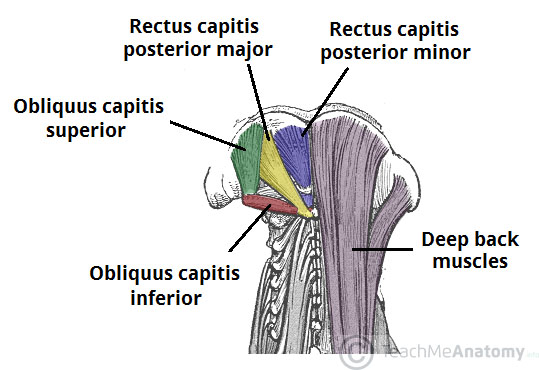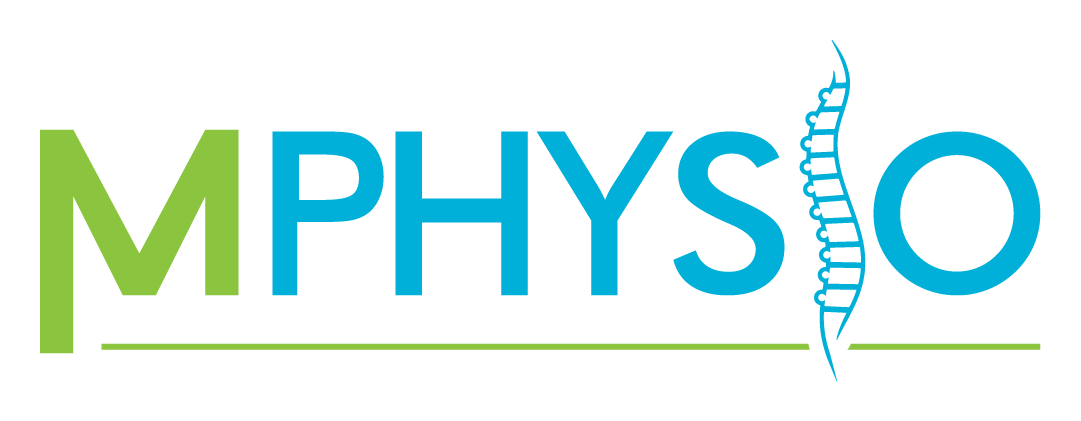Blog
Suboccipital Muscles and Cervicogenic Headache

There are many muscles in the neck which support the weight of your head, and help stabilise the very mobile cervical joints.
As seen in the image above, the suboccipital muscles are a group of four muscles located on each side of the upper cervical spines, just below the base of the skull. The muscles connect the skull with the top two vertebrae (C1 and C2) of the neck.
The suboccipital muscles
| Muscle | Origin | Insertion |
| Rectus capitis posterior minor | Posterior tubercle of C1 | Medial part of inferior nuchal line |
| Rectus capitis posterior major | C2 spinous process | Lateral part of inferior nuchal line |
| Obliquus capitis superior | C1 transverse process | Occipital bone (between superior and inferior nuchal lines) |
| Obliquus capitis inferior | Posterior tubercle of C2 | C1 transverse process |

Fig 2. Suboccipital muscles (http://teachmeanatomy.info/neck/muscles/suboccipital/).
These suboccipital muscles (muscles under the occiput) play an important role in not just the aforementioned functions, but also in controlling movements of your head and neck, provide sensory input and are also linked closely to vestibular and balance functions.
Symptoms?
However, when the suboccipital muscles become tightened, symptoms may occur. These could include:
- Stiff neck
- Neck pain
- Headaches with a band of pain on the side of the head that extends from the back of the head to the eye. This type of pain feels deeper in the head, and often it is difficult to describe
Messages sent to the brain may be altered, which is also why sometimes headache sufferers may also experience sensory symptoms, including dizziness and visual disturbances.
Clinical diagnosis
There are 3 main criteria that need to be met to be diagnosed with “cervicogenic headache”:
- Upper cervical spine joint dysfunction
- Reduced range of motion of the cervical spine
- Muscular impairments (especially deep cranio-cervical flexors and suboccipital muscles)
How can you help me?
Here at Musculoskeletal Physiotherapy Australia, our clinicians pay close attention to not just your suboccipital muscles, but other muscles around the head, neck and thoracic spine, including:
- Deep cervico-cranio flexors
- Trapezius
- Sternocleidomastoid
- Levator Scapulae
Management
Your clinicians may provide with some advice regarding your posture, any activity/work modifications, and self-management strategies to help manage your symptoms. With the aims of relieving headaches and neck pain, manual therapy to the upper cervical spines will most likely be provided. Our clinicians will also prescribe some exercises to help with decreasing the tension in your head and neck muscles. Together, these will help reduce the intensity, duration and frequency of your symptoms.
Ultimately, the management of your symptoms will depend on the subjective and objective assessments (patient interview and physical examination). Consult a clinician today to help you.
Reference
Thewellnessdigest.com. (2017). Suboccipital Muscles: Headaches, Migraines, Eye Pain – The Wellness Digest. [online] Available at: http://thewellnessdigest.com/suboccipital-muscles-headaches-migraines-eye-pain/ [Accessed 14 Oct. 2017].
TeachMeAnatomy. (2017). The Suboccipital Muscles. [online] Available at: http://teachmeanatomy.info/neck/muscles/suboccipital/ [Accessed 14 Oct. 2017].
